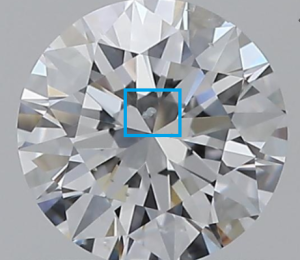In the multifaceted realm of gemology, diamonds hold an irreplaceable allure. Beyond their sparkle and hardness, diamonds fascinate with their complex inner world. This inner world often houses inclusions, or imperfections, each with a unique narrative to tell. One such inclusion, known as a knot, captivates the gemologists, jewelry designers, and diamond enthusiasts alike.

Formation and Structure of Knots
Knots are peculiar formations that occur when a diamond crystal envelops another diamond crystal during its growth. This phenomenon occurs deep within the earth’s mantle, under conditions of extreme pressure and temperature. As the host diamond continues to grow, the included diamond, or knot, becomes an integral part of its structure.
The enveloped diamond crystal, the knot, might reach the surface of the host diamond. If the knot extends to the polished surface of the diamond, it can disrupt the diamond’s surface continuity. This inclusion type stands out due to its potential to impact both the internal and external appearance of a diamond.
Identifying Knot Inclusions
Knots present unique identification challenges, primarily because they are formed from the same material as the host diamond. Therefore, they often share similar physical properties, such as refractive index and density.
Under magnification, knot inclusions appear as small, rounded or irregular formations. Their color can range from transparent to opaque, depending on their nature. If the knot extends to the diamond surface, it can be observed as a disruption or raised area. Moreover, in reflected light, the knot may display a different texture or luster compared to the surrounding diamond surface.
Professional gemologists often use advanced imaging techniques, including photomicrography and three-dimensional scanning, to accurately locate and describe knots. Additionally, gemologists may employ specialized tools such as loupes, microscopes, and diamond view instruments for knot detection and analysis.
Knots and Diamond Value
Knots’ impact on a diamond’s value largely depends on their size, position, and visibility. If the knot is large, near the surface, or disrupts the diamond’s brilliance, it can detract from the diamond’s value. However, if the knot is small, located deep within the diamond, and doesn’t interfere with light reflection, it may have minimal impact on the diamond’s value.
Interestingly, some collectors and jewelry enthusiasts find knots appealing for their unique story and rarity. This appreciation, while niche, can sometimes enhance the diamond’s overall allure.
The Beauty of Inclusions
While often regarded as flaws, inclusions like knots reveal the fascinating journey of a diamond’s formation, millions of years in the making. Each inclusion, each knot, narrates a unique story of transformation and resilience, encapsulating the miraculous wonders of nature. From a gemological standpoint, knots and other inclusions also present a world of exploration, fueling the ongoing curiosity and passion of gemologists worldwide.
As we come to understand and appreciate these intricate details, the perception of inclusions as flaws begins to shift. Knots, alongside other inclusions, become symbols of individuality, adding to a diamond’s unique fingerprint.
In conclusion, knot inclusions offer a captivating perspective on diamond gemology. These microscopic formations encapsulate stories of the earth’s violent forces, the diamond’s resilient growth, and the complexity of nature’s most dazzling creations. Whether you’re a gemologist, a diamond enthusiast, or a jewelry lover, the fascinating world of diamond knot inclusions is sure to enthrall.